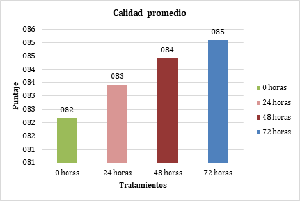Anaerobic fermentation time in the quality of Coffea arabica L. var. Catimor with Honey process, in Satipo-Perú
DOI:
https://doi.org/10.51252/raa.v2i2.359Keywords:
humidity, mucilage, organoleptic, parabolicAbstract
This research sought to evaluate three fermentation times 0, 24, 48 and 72 hrs in the quality of Catimor variety coffee with Honey process. The work was carried out in the field and laboratory. The variables evaluated were organoleptic, physical and microbiological. The results show that the maximum quality score reached is 85.08 with a 72-hour fermentation; then with 48 hours and with 24 hours; the control with 0 hrs shows a lower score; the quality grows with the fermentation time in a parabolic curve with a maximum of 120 hours. The analysis of molds indicates that at 0 and 72 hours there is a higher amount of CFU/g, while at 24 and 48 hours it is lower. At 35.19 it has less quantity. According to physical analysis at 0 and 72 hours there is less moisture in grains; while at 24 and 48 hours it is higher and to reach 11% it takes 61.2 hours. It is concluded that the fermentation hours increase the yield percentage, varying from 72.9% with 0 hours and 76.37% with 72 hours; the maximum is found with 88.1 hrs.
Downloads
References
Ayala Ceballos, D. C. (2020). Evaluación de las propiedades sensoriales del café variedad castillo, caturra y Colombia(coffea arábica l.) durante el proceso de secado Honey, a diferentes alturas sobre el nivel del mar en fincas cafeteras de la zona norte del departamento de Nariño [Universidad Nacional Abierta y a Distancia]. https://repository.unad.edu.co/handle/10596/36886
Blandón-Castaño, G., Rodríguez-Valencia, N., & Dávila-Arias, M. T. (1998). Caracterización microbiológica y físico química de los subproductos del be-neficio del café en proceso de compostaje. Cenicafé, 49(3), 169–185. http://hdl.handle.net/10778/753
Boyacá Vásquez, L. A. (2018). Estudio exploratorio de la obtención de café verde mediante beneficio Honey y la determinación de su calidad en taza [Universidad Nacional de Colombia]. https://repositorio.unal.edu.co/handle/unal/69512
Córdoba-Castro, N. M., & Guerrero-Fajardo, J. E. (2016). Caracterización de los procesos tradicionales de fermentación de café en el departamento de Nariño. Biotecnología en el Sector Agropecuario y Agroindustrial, 14(2), 75–83. https://doi.org/10.18684/BSAA(14)75-83
Córdoba Rafael, F., & Efus Díaz, Y. A. (2021). Determinación del Rendimiento y Calidad en Taza del Café (Coffea arabica L.) en las Variedades Caturra y Catimor, Distrito de Huabal - Jaén 2020 [Universidad Nacional de Jaén]. http://repositorio.unj.edu.pe/handle/UNJ/103
Gálvez-López, R. A. (2018). Optimización del proceso fermentativo Honey en café especial variedad Pacamara, Finca Santa Rosa, El Salvador [Escuela Agrícola Panamericana]. http://hdl.handle.net/11036/6253
Jarata Quispe, E. (2015). Evaluación de perfiles de taza en tres zonas productoras de café (Coffea Arábica) variedad Catimor en el valle del Distrito de Ayapata-Carabaya [Universidad Nacional del Altiplano]. http://repositorio.unap.edu.pe/handle/UNAP/2790
Ladino-Garzón, W., Cortés-Macías, E. T., & Amorocho-Cruz, N. G.-G. C. M. (2016). Calidad de taza de café ( Coffea arabica L .) procesado en fermentación semi-seca Coffee ( Coffea arabica L .) cup quality processed by semi-dry method. Agronomía Colombiana, 34(1), 281–283. https://doi.org/10.15446/agron.colomb.v34n1supl.57773
Lugo Ruiz, H. A. (2019). Evaluación de la percepción de dulzura y el contenido de azúcares presentes en las variedades de café Parainema (Sarchimor), IHCAFE 90 (Catimor) y Typica. http://hdl.handle.net/11036/6568
Paima Flores, J. K. (2017). Influencia de tres pisos altitudinales en las características físicas y sensoriales del café (Coffea arábica L.) variedad Catimor en los distritos de Lamas y Alonso de Alvarado Roque. Tesis [Universidad Nacional de San Martín]. https://repositorio.unsm.edu.pe/handle/11458/3236
Patiño-Velasco, M. M., Pencue. Fierrro, E. L., & Vargas-Cañas, R. (2016). Determinación del contenido de humedad en granos de café pergamino seco utilizando Speckle dinámico. Biotecnología En El Sector Agropecuario y Agroindustrial, 14(2), 84–91. https://doi.org/10.18684/BSAA(14)84-91
Puerta Quintero, G. I., González Rizo, F. O., Correa Piedrahita, A., Álvarez Lizcano, I. E., Ardila Calderón, J. A., Girón Ospina, O. S., Ramírez Quimbayo, C., Julio, Baute Balcázar, J. E., Sánchez Arciniegas, P. M., Santamaría Burgos, M. D., & Montoya, D. F. (2016). Diagnóstico de la calidad del café según altitud suelos y beneficio en varias regiones de Colombia. Cenicafé, 67(2), 15–51. https://n9.cl/tepnn
Rojas Checca, L. A. (2017). Evaluación física y organoléptica de tres var. de café (Coffea arábica L.) con cuatro tiempos de fermentación, en tres pisos altitudinales de la zonal de Palma Real, Echarate - La Convención [Universidad nacional deSan Antonio Abad del Cusco]. http://hdl.handle.net/20.500.12918/1913
SCAA (Speciality Coffee Association of América). (2007). Protocolo para catar SCAA (Speciality Coffee Association of América). Foro Café. https://forocafe.es/foro/viewtopic.php?t=1691
Untiveros Soldevilla, C. M. (2021). Métodos de beneficio (Honey, lavado y natural) sobre la calidad organoléptica de Coffea arábica L. variedad catimor [Universidad Nacional del Centro del Perú]. http://hdl.handle.net/20.500.12894/7069

Published
How to Cite
Issue
Section
License
Copyright (c) 2022 Jose Alomia-Lucero, Diana Rojas-Medina , Gloria Mamani-Santana, Leocadia F. Pérez-Romero , Hebert N. Estrada-Carhuallanqui , Miriam D. Cañari-Contreras

This work is licensed under a Creative Commons Attribution 4.0 International License.
The authors retain their rights:
a. The authors retain their trademark and patent rights, as well as any process or procedure described in the article.
b. The authors retain the right to share, copy, distribute, execute and publicly communicate the article published in the Revista Agrotecnológica Amazónica (RAA) (for example, place it in an institutional repository or publish it in a book), with an acknowledgment of its initial publication in the RAA.
c. Authors retain the right to make a subsequent publication of their work, to use the article or any part of it (for example: a compilation of their works, notes for conferences, thesis, or for a book), provided that they indicate the source of publication (authors of the work, journal, volume, number and date).









